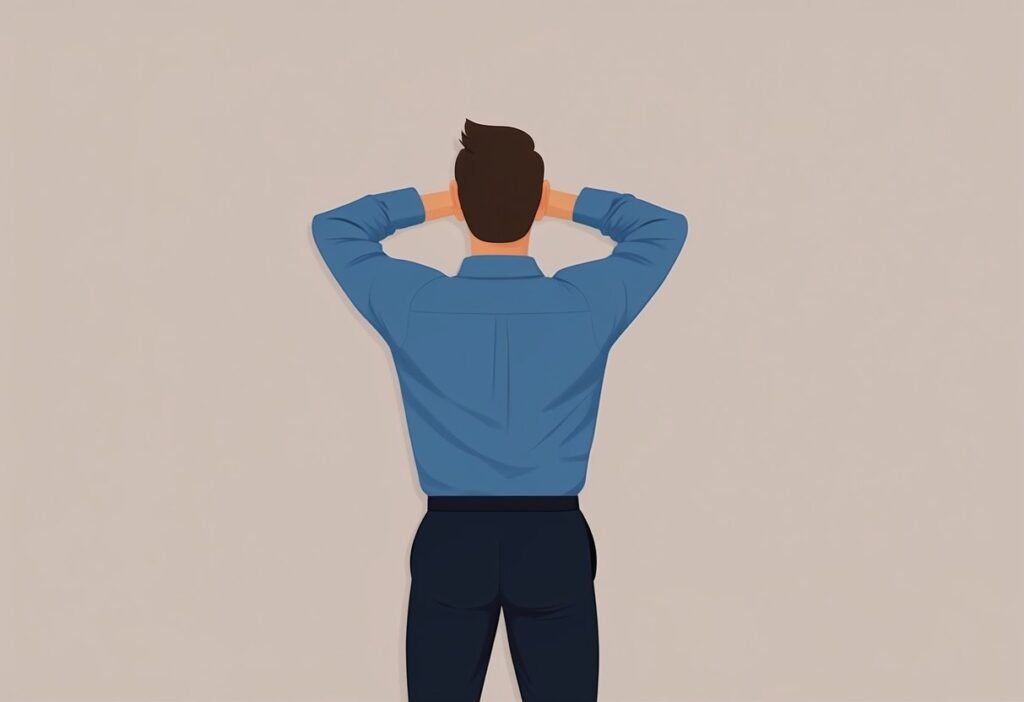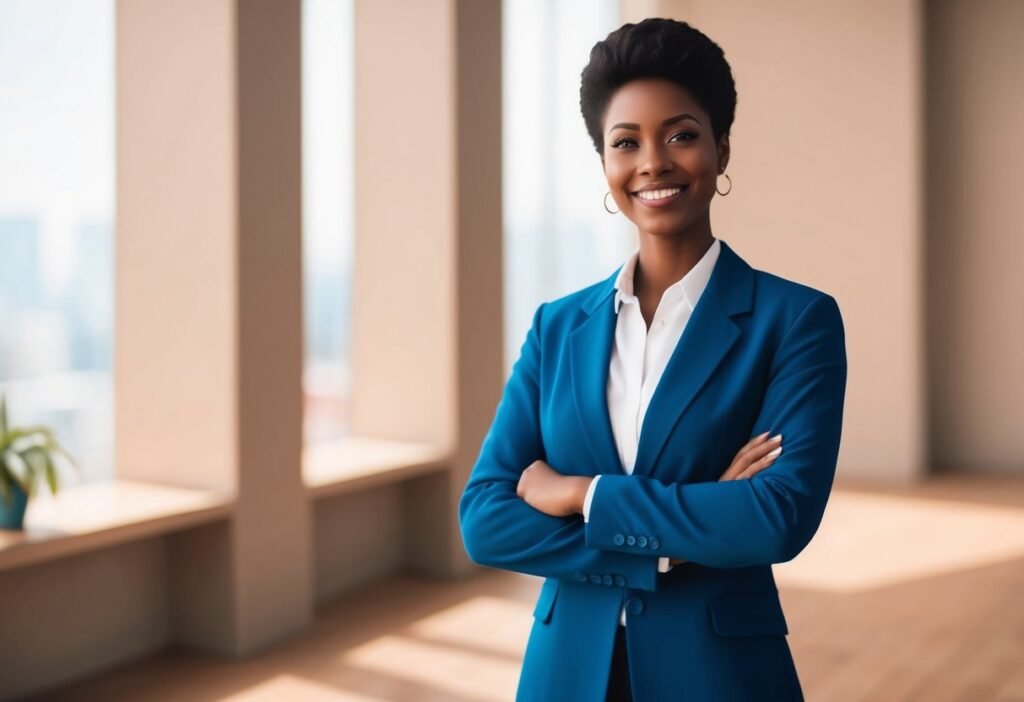Table of Contents
Ever noticed how some people walk into a room and instantly command attention? It’s not just what they say, but how they carry themselves. Body language speaks volumes before words are ever exchanged.

Simple adjustments to posture, eye contact, and gestures can dramatically increase perceived confidence and create positive first impressions. These non-verbal cues send powerful messages about a person’s self-assurance and competence, often unconsciously influencing how others respond to them.
Learning these body language tricks doesn’t require special talent – just awareness and practice. Anyone can develop the physical habits that project confidence, even when they’re feeling uncertain inside. These techniques work in job interviews, social gatherings, and everyday interactions where making a strong impression matters.
Understanding the Basics of Body Language

Body language reveals our true feelings and intentions through physical signals that often bypass conscious awareness. These nonverbal cues significantly impact how others perceive us and can either strengthen or undermine our verbal messages.
The Role of Nonverbal Communication
Nonverbal communication accounts for 55-93% of message interpretation in human psychology. This silent language operates continuously, even when we aren’t speaking.
Our subconscious mind processes these signals automatically, forming impressions within seconds of meeting someone new. A first impression forms within 7 seconds, primarily based on body language rather than words.
Body language includes:
- Facial expressions (smiles, frowns, raised eyebrows)
- Posture (how you stand, sit, or walk)
- Gestures (hand movements, nodding)
- Eye contact (engagement level, interest)
- Personal space (proximity to others)
These nonverbal elements often communicate more honestly than words, as they’re harder to consciously control.
Interpreting Common Body Language Signals
Understanding basic body language signals helps interpret others’ true feelings and project confidence.
Confident signals include:
- Standing tall with shoulders back
- Making appropriate eye contact
- Using purposeful gestures
- Taking up appropriate space
Insecure signals often manifest as:
- Crossed arms or legs (defensive barriers)
- Avoiding eye contact or excessive blinking
- Fidgeting or self-touching behaviors
- Hunched posture or making oneself smaller
Cultural differences significantly impact body language interpretation. A gesture considered respectful in one culture might appear rude in another.
Body language should be read in clusters rather than isolating single movements. Context matters—someone crossing arms might simply feel cold rather than closed off.
Mastering Confident Body Language

Body language speaks volumes about our confidence level, often communicating more than our words. The way we carry ourselves physically can transform how others perceive us and how we feel about ourselves.
Powerful Posture and Its Impact
Good posture forms the foundation of confident body language. Standing or sitting with a straight back, shoulders pulled back, and head held high instantly makes anyone appear more self-assured. This “power posture” triggers hormonal changes that actually reduce stress and increase confidence.
Amy Cuddy’s research demonstrates that holding “power poses” for just two minutes can increase testosterone (the dominance hormone) and decrease cortisol (the stress hormone). This biological shift can help people feel more confident before important situations like interviews or presentations.
The impact goes beyond internal feelings. People with good posture are perceived as more capable, authoritative, and trustworthy. Simply adjusting how you stand or sit can change both how you feel and how others respond to you.
Using Gestures to Convey Confidence
Hand gestures can greatly enhance perceived confidence when used correctly. Purposeful, smooth movements appear more authoritative than fidgeting or keeping hands hidden.
Confident gesture examples:
- Open palm gestures (showing honesty)
- Steepling fingers (displaying authority)
- Measured hand movements (showing control)
- Taking up appropriate space (demonstrating comfort)
Avoid gestures that signal nervousness like touching your face, playing with objects, or crossing arms defensively. These movements create barriers between you and others.
Well-timed gestures that match your speech enhance your message and make you appear more dynamic. The key is keeping movements deliberate rather than random or jittery.
Facial Expressions That Show Assurance
The face communicates confidence through authentic expressions and appropriate eye contact. A genuine smile activates the muscles around the eyes (the “Duchenne smile”) and creates instant connection and trust.
Maintaining comfortable eye contact shows engagement and conviction. The ideal approach is to hold eye contact for 4-5 seconds before briefly looking away, then reconnecting. This pattern feels natural rather than intimidating or avoidant.
Controlling facial tension also matters. Relaxed jaw muscles and an unclenched forehead project calm confidence. Practice awareness of facial tension, especially during stressful situations.
Facial expressions should match the content of your message. Appropriate expressions reinforce your words while mismatched expressions can undermine your credibility, making others question your sincerity or competence.
Practical Techniques for Self-Confidence

The path to greater self-confidence flows through our body language choices and mindful practices. These practical methods can help anyone appear and feel more confident in daily situations.
Building Confidence Through Body Language Exercises
Standing tall creates an immediate boost in how others perceive you. Try the “Mountain Pose” by standing with feet hip-width apart, shoulders back, and chest open. This posture signals strength to your brain and others.
Mirror practice helps develop awareness of how you present yourself. Spend 5 minutes daily observing your typical expressions and postures, then adjust them to reflect confidence.
Body language experts recommend the “3-Point Check” technique throughout the day:
- Straighten your spine
- Relax your shoulders
- Lift your chin slightly
Walking with purpose also changes how you feel. Take slightly longer strides and swing your arms naturally. This purposeful movement creates a feedback loop that builds genuine self-confidence over time.
Harnessing the ‘Power Pose’ Strategy
The power pose technique involves adopting expansive postures that take up space. Research suggests holding a power pose for two minutes can decrease cortisol (the stress hormone) and increase confidence.
Try these effective power poses:
- The Wonder Woman: Stand with feet apart and hands on hips
- The Victory: Raise arms in a V-shape above your head
- The CEO: Sit with legs apart and arms resting on chair arms
These poses work best when done privately before important events. A bathroom stall or empty meeting room provides perfect privacy for your two-minute confidence boost.
The brain responds to these physical signals even when artificially created. By changing your body position, you can trick your mind into feeling more confident when facing challenging situations.
Mindful Practices to Feel More Confident
Breathing techniques create immediate confidence shifts. Take a deep breath through your nose for four counts, hold for two, then exhale slowly for six counts. This calms your nervous system and reduces anxiety.
Visualization prepares your mind for success. Spend five minutes daily imagining yourself handling situations with confidence and poise. Your brain rehearses these scenarios, making them easier in real life.
Positive self-talk reinforces confidence from within. Replace thoughts like “I can’t handle this” with “I have the skills to manage this challenge.” This internal dialogue shapes how you carry yourself.
Grounding exercises help during nervous moments. Press your feet firmly into the floor and notice the sensation. This physical awareness interrupts anxiety cycles and returns you to the present moment.
Strategies for Different Scenarios

Body language varies across different situations. The right nonverbal cues can help you project confidence whether you’re at a party, in a meeting, or during a job interview.
Exuding Confidence in Social Settings
In social gatherings, open posture signals approachability. Stand with feet shoulder-width apart and avoid crossing your arms, which can make you appear defensive.
Make eye contact with people when they speak. This shows you’re engaged and comfortable in your own skin. A genuine smile goes a long way too.
Move purposefully through the room rather than darting or shuffling. Confident people take their time and occupy space naturally.
When joining conversations, approach at a slight angle rather than head-on, which can feel confrontational. Mirror others’ energy levels slightly to create rapport.
Remember to breathe deeply if you feel nervous. No one can tell you’re taking calming breaths, but the relaxed posture it creates is visible to everyone.
The Art of Confident Interaction in the Workplace
Professional settings require balanced confidence signals. Sit or stand tall with shoulders back, but remain relaxed—rigid posture can appear uncomfortable or overly formal.
When speaking in meetings, use deliberate hand gestures to emphasize key points. Keep movements between waist and shoulder height for maximum effect.
Power Positioning Techniques:
- Choose seats that face the door in meetings
- Stand at the head of the table when presenting
- Keep your hands visible, not hidden in pockets or under the table
Walk with purpose between locations. A brisk, steady pace projects confidence and competence to colleagues.
Make notes visibly during discussions to signal engagement, but maintain regular eye contact to show you’re present and attentive.
Making a Memorable Impression in Interviews and Meetings
First impressions form quickly, so enter the room confidently. A firm handshake, direct eye contact, and a genuine smile create immediate positive impact.
Sit slightly forward in your chair to demonstrate interest. This posture helps you appear engaged rather than passive.
Control nervous habits by keeping hands gently clasped or resting on the table. Avoid fidgeting with objects, hair, or clothing.
Match your facial expressions to the conversation. Appropriate reactions signal to the other person that you’re processing information thoughtfully.
When answering questions, pause briefly before responding. This short delay appears thoughtful rather than reactive and helps you formulate clearer answers.
Remember that confident body language in high-stakes situations isn’t about dominating space—it’s about appearing comfortable despite pressure.
Overcoming Nervousness and Negative Body Signals

Negative body language can undermine self-confidence and how others perceive you. Learning to identify and modify these signals puts you back in control of your nonverbal communication.
Identifying and Modifying Nervous Habits
Nervousness often manifests in the body before the mind fully registers it. Common signs include slouching, crossing arms tightly, fidgeting, or avoiding eye contact. These physical behaviors broadcast anxiety to everyone in the room.
Start by monitoring your typical responses in stressful situations. Do you play with your hair? Tap your foot? Hunch your shoulders? Awareness is the first step toward change.
Replace these habits with confident alternatives. When you feel the urge to cross your arms (a closed-off signal), try keeping them relaxed at your sides or using purposeful gestures instead.
Bad posture sends a powerful message about your confidence level. Stand tall with shoulders back and chest open. This stance not only projects confidence but actually triggers confidence-boosting hormones.
Aligning Verbal and Body Language Signals
When your words say one thing but your body says another, people usually trust the body language. This disconnect creates confusion and diminishes your message’s impact.
Practice congruence between your verbal and nonverbal communication. If you’re expressing enthusiasm, your arm movements, facial expressions, and voice tone should match that energy.
Record yourself during practice presentations to spot misalignments. Many people claim to feel confident while unconsciously displaying nervous signals.
Open body positioning helps reinforce your words. When making important points, adopt a stable stance with feet shoulder-width apart. Use deliberate hand gestures to emphasize key ideas.
Remember that appropriate eye contact is crucial. Looking away while speaking suggests uncertainty about your own message.



